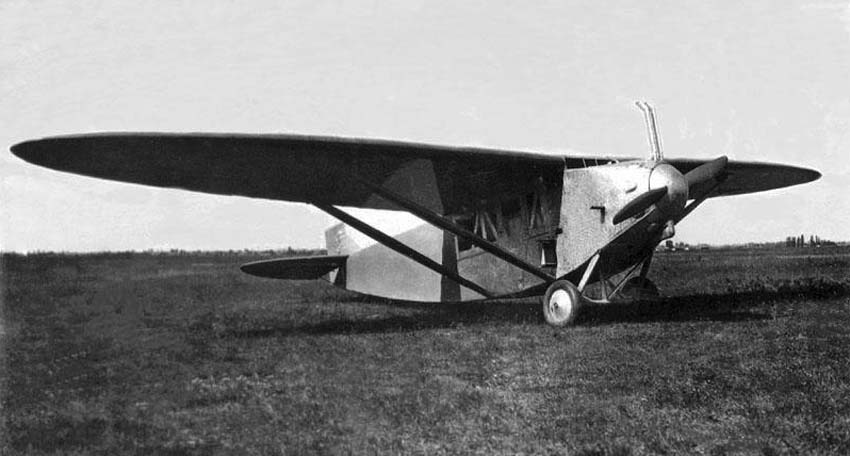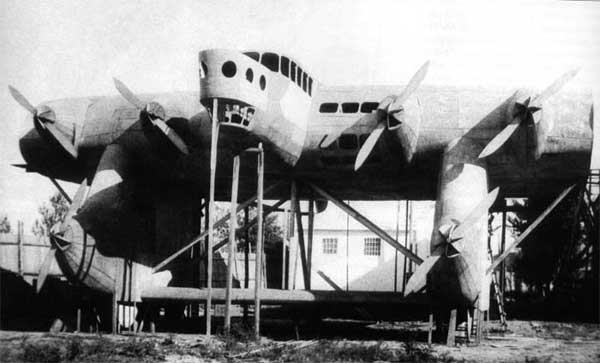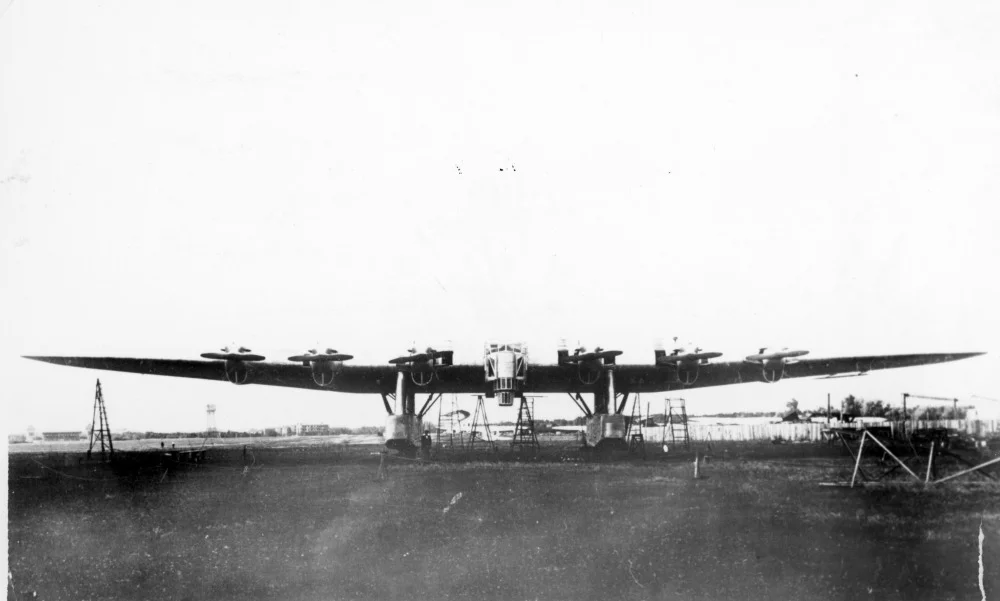The Kalinin K-7 was an experimental bomber aircraft designed in the Soviet Union in the early 1930s. It was designed as a heavy bomber reinforced with multiple machine gun turrets but the designs also imagined the plane could double as a commercial airliner with modifications.

Much like other experimental Soviet designs, the K-7 was planned with size in mind and the result was a giant, hulking machine that defied imagination at the time.
The aircraft was conceived by prominent Soviet designer Konstantin Kalinin who set to work on the plane in 1931 at his workshop in Ukraine (then part of the Soviet Union). Although the aircraft was considered a source of pride for the Soviet government, only one example was constructed.
It was also found during test flights that the plane had severe and potentially dangerous vibration issues which led to a redesign of the airframe.
Testing continued until the K-7 was destroyed in a mysterious crash, with findings attributing elevator failure as the cause.
The lack of conclusive evidence led to a number of political conspiracy theories and accusations of terrorism being put forward which to this day remain unproven.
Origins
The K-7 was the creation of Soviet aviator and aircraft designer Konstantin Kalinin.
Kalinin had served as a pilot with the Russian Air Force during the First World War before becoming a pilot for the communist Bolshevik faction at the height of the Russian Civil War. He later took a job as a flying instructor at a technical school in Ukraine which at the time was a Soviet territory.
After the Red Bolshevik faction were victorious in the civil war and withdrew Russia from the First World War, Kalinin joined the Soviet Communist Party and became the chairman of a design bureau in Kharkiv, Ukraine.
 A previous aircraft from Kalinin, the K-1. Like the K-7, it had a large elliptical wing.
A previous aircraft from Kalinin, the K-1. Like the K-7, it had a large elliptical wing.
In the 1930s, the Soviet regime began to invest more money and resources into new aircraft production, in part due to Germany, Britain and the United States expanding their military capabilities.
Although the new plane was primarily intended for defense purposes, the K-7’s designers also sought to push new boundaries when it came to the size and length of the plane, hoping to showcase Soviet ingenuity to the world and provide competition to Western made aircraft.
Under his leadership, Kalinin and his bureau had already designed successful airframes such as the Kalinin K-4 and K-5 commercial airliners. He started to conceive a giant new aircraft design in 1931 in response to the demands for bigger and more impressive aircraft by Stalin’s regime.
The K-7
From the outset, Kalinin envisaged his new design as one of epic proportions, and, compared to modern aircraft, his plane is still considered substantial.
The design had a wingspan of up to 173 feet, a total length of 91 feet and a height of 40 feet. When empty, the K-7 had a weight of around 54,000 pounds making it one of the heaviest aircraft of its era. When fully loaded with cargo and passengers, it was calculated that the plane would weigh a hefty 84,000 pounds.
To power such a giant machine and get it off the ground, Kalinin designed the aircraft with six engines. These would be driven by Mikulin AM-34F V12 diesel engines, which produced 750 horsepower each. Each unit would drive a two bladed propeller.
Even then, Kalinin predicted six engines would not be enough. A seventh engine was added in a rear-facing “pusher” configuration on the back of the wings to add extra power. An earlier design allegedly had more engine units housed in pods with the undercarriage.
 An early mock-up of the K-7. Note the engines and propellers integrated into the landing gear pods.
An early mock-up of the K-7. Note the engines and propellers integrated into the landing gear pods.
The K-7 would be constructed from welded steel sourced from within the Soviet Union, a fact that would come heavily into play in state propaganda promoting the new aircraft.
The projected maximum speed of this huge machine was around 140 miles per hour with a climb ceiling of 13,000 feet.
Kalinin envisaged the aircraft would be used for both military and civilian purposes. In a military configuration, the K-7 would be used as a bomber and a troop transporter.
It would be able to accommodate up to 112 fully equipped paratroopers and as a bomber it would be armed with up to eight 20 mm cannons, 8 machine guns in turrets dispersed along the fuselage and up to 21,200 pounds worth of bombs.
Some of the machine gun turrets were housed in the pods containing the undercarriage. The finished result resembled a flying battleship in some preliminary designs.
 Another view of the K-7 mock-up. This image shows a cross-section of the wings, highlighting their extreme thickness.
Another view of the K-7 mock-up. This image shows a cross-section of the wings, highlighting their extreme thickness.
As an airliner, Kalinin believed the K-7 would have the capacity to ferry 120 passengers and around 15,000 pounds of freight and mail bags.
In all configurations, it was planned that the aircraft would carry a flight crew of eleven; these would comprise of pilots, radio operators and navigators who could also double as gunners in the military edition.
The crew and passenger compartment were housed within a nacelle at the front of the fuselage and fitted with large window casings to allow for unobstructed views.
The rear section of the fuselage was constructed within twin booms which also made up the tail. The undercarriage for the design was also fitted in a fixed position and housed in large pod casings beneath the wings.
Construction began in 1931 in Kharkiv once the initial design process was finished and it took two years to construct a working prototype of the K-7.
 The completed K-2. It had an enormous wingspan of 53 meters.
The completed K-2. It had an enormous wingspan of 53 meters.
The sheer size and capacity of the K-7 was promoted as a source of pride for the Soviet Union. The Russian state newspaper Pravda first acknowledge its existence to the public in 1933 and then proceeded to make a show of the fact the K-7 was built from Russian steel as opposed to imported components and claimed the new plane would become a worthy rival to designs produced in the West.
Testing
The K-7 completed its maiden flight on the 11th of August 1933 in Kharkiv under the control of Soviet test pilot M.M. Gromov.
The initial test flight was brief, as severe vibration issues were detected in the airframe which caused instability and engine trouble. It is believed the engine frequency caused the large but rigidly made airframe to violently oscillate and shake about.
Although an issue now understood by aerospace engineers, there was little information or research on this phenomenon at the time, with test pilots discovering these flaws with each new design experiment.
Kalinin and the designers decided to rectify the problem by shortening and strengthening the tail booms in a bid to make the vibrations go away.
 The K-7’s AM-34 V12 engine nacelle. They would go on to power a number of vehicles, including the T-100 and SMK heavy tanks.
The K-7’s AM-34 V12 engine nacelle. They would go on to power a number of vehicles, including the T-100 and SMK heavy tanks.
However, subsequent test flights found the vibration issue to persist and after more probing they were found to be caused by the giant propellers.
In addition, the K-7’s engines were found to be underpowered, especially when trying to lift an aircraft of the K-7’s size and weight. As a result, the aircraft was slow and had a limited range.
The K-7 completed seven proving flights before it tragically crashed on the 21st of November 1933 after experiencing a critical structural failure.
The reports into the accident stated that the probable cause was likely due to one of the tail booms suffering from an elevator failure. The jammed elevator then sent the K-7 into an uncontrolled pitch towards the ground.
The fatal flight reportedly had eighteen crew members and one passenger on board. All but five people on the K-7 were killed and one person on the ground also died after being struck by debris.
Political theories
Following the crash, a number of theories of deliberate sabotage or terrorism were put forward, especially as the K-7 had been regarded as a source of national pride by the ruling Communist Party and the exact cause of the crash was neither fully determined not shared with the public at the time.
Allegedly the Joint State Political Directorate (the then secret police of the Soviet Union and one of the precursors to the KGB) launched an investigation into potential sabotage of the aircraft with some Soviet officials blaming foreign involvement in the crash.
 To this day, there are still conflicting theories about what brought about the end of the K-7.
To this day, there are still conflicting theories about what brought about the end of the K-7.
However, other theories put forward have also blamed domestic political interference or potential sabotage from within the Soviet Union. A competing design by renowned designer Andrei Tupolev was being tested at this stage and questions were raised whether political involvement had played a role in the incident.
To date, none of these accusations have been proved or at least been presented to the public with any conclusive findings and they continue to be debated by historians.
Aftermath
Although Kalinin had hoped to enter the K-7 into mass production, no more prototypes were built after the initial example was written off in the crash. The Soviet government officially cancelled the project in 1935, only four years after the K-7’s development had begun.
Kalinin continued proposing experimental designs, including the tailless K-12 bomber in 1936 and the rocket powered K-15 fighter, neither of which were put into production.
However, his career was cut short when he was arrested by secret police and executed on allegations of conspiracy as part of the mass Stalinist purges during the 1930s.
Soviet records indicate his death was in 1940. Kalinin’s name lived on though when the Kharkiv Aviation Institute in Ukraine was named after him.
Although the K-7 project was ultimately unsuccessful and not many photographs exist of it flying, it still continues to be regarded as one of the most ambitious aircraft designs of its kind.





